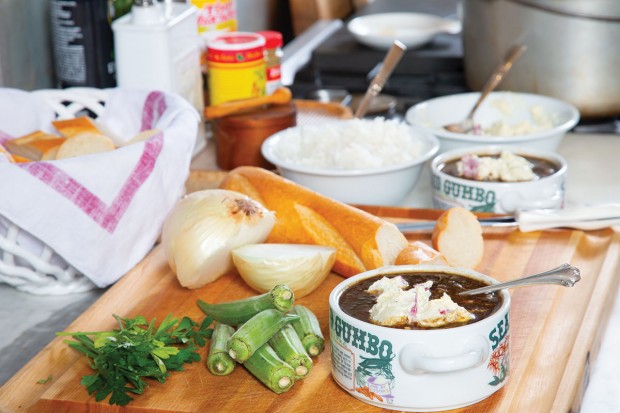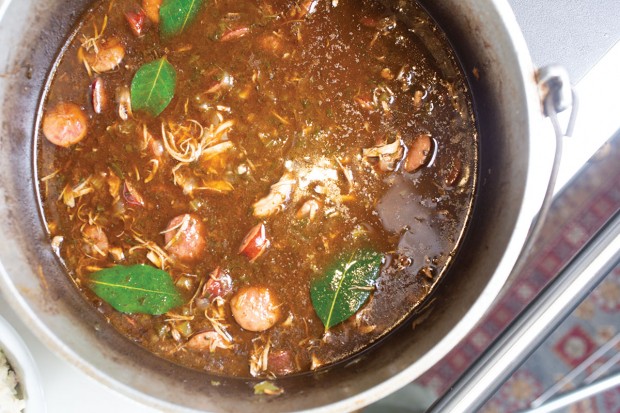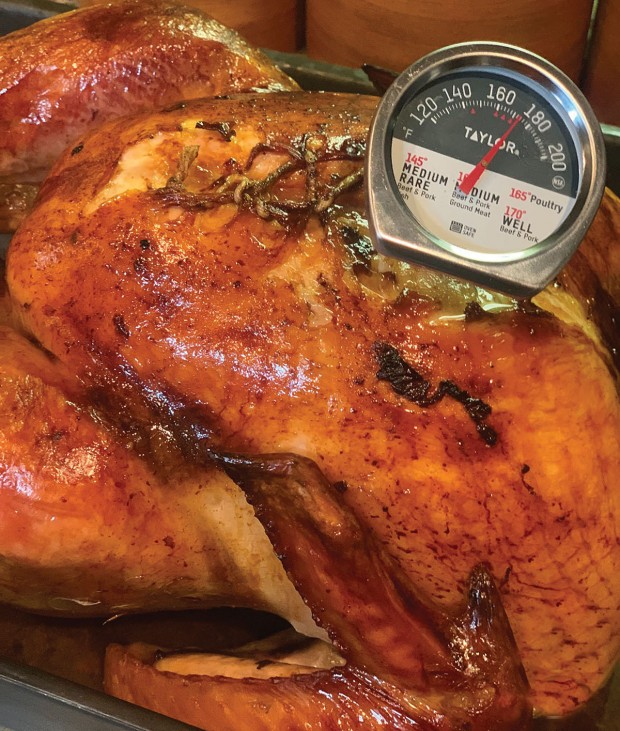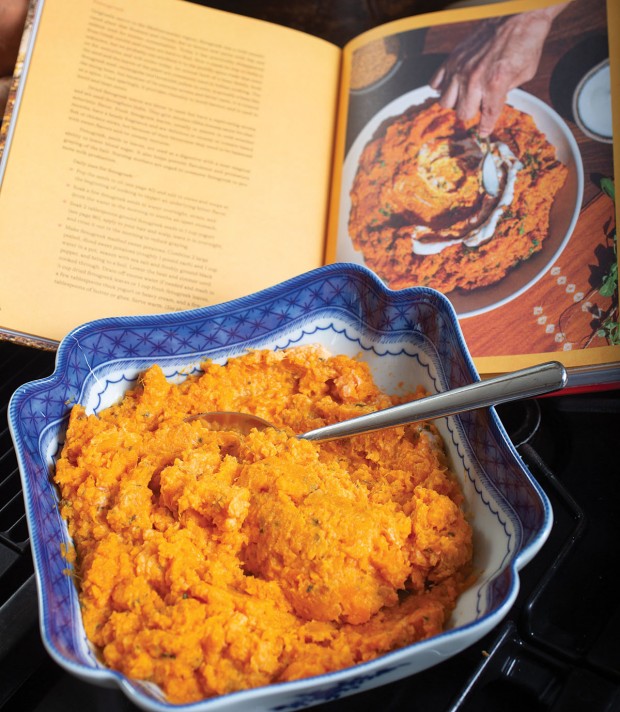Storied Thanksgiving Recipes
Not your average turkey and dressing


SOUP FOR YOU Jean Jenner and her mother Nathalie Willig have served gumbo for many years in Nathalie’s gumbo bowls. Nathalie will turn 100 this spring. (Photo: lawellphoto.com)
Jean Jenner says that growing up in New Orleans, she didn’t really like gumbo.
“It was sort of a necessity,” the retired audiologist, who’s lived in Houston for 35 years, says. “Gumbo originated in the lower economic class we were in. It’s what you make when you throw together a bunch of leftovers, and it can feed hundreds of people.” Then she quips, “I didn’t know that when I was growing up, but now I’ve watched The Bear.”
“Same thing with jambalaya. And red beans and rice on Mondays; the fishermen had a day off, so you couldn’t get fresh seafood on Mondays. So when I was growing up, I was kind of like Oh, gumbo again.”

NEW ORLEANS IN HOUSTON Gumbo is a Jenner family post-Thanksgiving tradition. Jean Jenner says gumbo isn't as hard to make as people might think. Serve gumbo with a green salad, French bread, and a scoop of rice (or cold potato salad if you are from Louisiana, like the Jenners). (Photo: lawellphoto.com)
Jean’s grandmother – the cook in the family – was Sicilian, and her grandfather was Cajun. Mamadear, as Jean’s grandmother was known, was used to making tomato sauces, while Nampy, her grandfather, was a hunter and fisherman. When they fed their family, a typical Sunday dinner would include eggplant parmesan and stuffed artichokes, some sort of wild game, and cannoli for dessert. “It was all Italian roots with a little bit of Cajun,” Jean says.
She adds, “My mom was a good cook, but my grandmother was such a good cook that all my mom really did was the presentation. Cooking from scratch wasn’t so much in vogue when she was younger. Although I do remember stirring the pot for her every now and then.” Jean’s mom, Nathalie Willig, moved to Houston from New Orleans just five years ago. She will turn 100 next spring.
Jean’s family would have gumbo five or six times during the winter, but she says the real treat was the gumbo her grandmother made with Thanksgiving leftovers. “The turkey carcass is the best thing ever for a base,” she explains. Her turkey and sausage gumbo has become the Jenner family’s Thanksgiving leftover tradition.
“It’s the best gumbo you’ll ever have – don’t throw the turkey carcass away,” Jean says. “You can add the gravy. My grandmother used to add some stuffing if it wasn’t thick enough. I chop up the liver, gizzards, all that, because it adds a richness and a flavor you can’t reproduce. You just can’t really recreate it unless you have the turkey from Thanksgiving.”
Jean says not to be afraid of what some think is a daunting process. “Once you get over making the roux, it’s the easiest thing to make,” she says. “You don’t need to wake up at 7 a.m.; you can simmer for a couple hours and it’s fine. It just takes a little bit of patience.” Jean says a recent roux took an hour to make. “I just put some music on – The Mavericks or Eagles Radio – had a glass of wine, and talked to my dog,” she says. “If you need to cheat, there is a roux that comes in a jar. Tony Chachere’s [Instant Roux] is my favorite. If my roux is not dark enough, I’ll put a little of that and some water in and [the gumbo] will darken up.” Jean also uses the Tony Chachere’s as a base for Thanksgiving gravy.
Even though she cooks most of the Thanksgiving Day meal (except for the manicotti – husband Rick’s mother is Italian, too), Jean says she can’t wait to wake up and cook again on Friday morning, surrounded by her family. “And I might have a Bloody Mary while I’m doing it, but don’t quote me.”
Jean Jenner’s Thanksgiving Leftovers Turkey and Sausage Gumbo
2 medium bell peppers
6 large sticks celery, including the inner tender sprigs and leaves
2 sweet onions
6 cloves garlic
1 bunch parsley, chopped, divided
1 cup fat (Jean uses ½ cup bacon grease and ½ cup vegetable oil, but you can swap based on what you have and like)
1 cup flour
1 quart chicken or beef broth
Meat (no skin) from leftover Thanksgiving turkey, chopped or torn (or meat from 2 rotisserie chickens), including all the juices
Any leftover vegetables from the turkey
1 pound sliced andouille sausage (or your favorite sausage)
1 cup leftover Thanksgiving gravy (or ½ cup Tony Chachere’s Instant Roux mixed well with cold water)
1 tablespoon Tabasco
1 tablespoon Worcestershire sauce
Salt and pepper to taste
Gumbo filé for serving, optional
Finely chop all the vegetables (do not use a food processor, as this will make them too fine). Place in a large bowl.
To make the roux, place the fat in a large cast iron pot or a large stockpot/Dutch oven, and heat over medium. When it starts to sizzle, add flour and stir constantly with a whisk or wooden spoon over medium heat so the roux does not burn. This can take 30 minutes to an hour, so have a glass of wine ready and a good movie on. When the roux is a peanut-buttery or cocoa color, add all the veggies and half the parsley. Immediately add the chicken or beef broth. Let simmer for 45 minutes on low. If it looks dry, add a little water as needed. Add the turkey and sausage, gravy, Tabasco, Worcestershire, and salt and pepper, and let the gumbo simmer for as long as you like. Hint: The gumbo is even better the next day and freezes beautifully. Serve with a green salad, French bread, and a scoop of rice (or cold potato salad if you are from Louisiana!). Sprinkle the rest of the parsley on top.

HOLIDAY TURKEY Linda Elston’s father Richard Wedel was forever in charge of their family’s Thanksgiving turkey. When he died a few years ago, Linda took over and now makes a turkey brined with apples and oranges.
Designer and builder Linda Elston’s family is also Italian – and German – and they also make turkey gumbo after Thanksgiving. But they add an extra Italian element: “We have a big crowd,” she says, “and the day or weekend after the holiday, we bust out enough meatballs to feed an army! It’s a cooking fest for the whole weekend.
“Saturday we’ll invite the whole gang over again, and whatever meatballs we don’t eat, we’ll freeze and have for Christmas. We’re the typical Italian family where everything happens around food.”
For years, Linda’s father Richard Wedel (a.k.a. Dick, a.k.a. Pops) was in charge of the turkey. “When he was sick [with Alzheimer’s], my stepmother, who is from Korea, took over the turkey,” Linda says, “but it was always dry. So when he passed, I took over.”
In search of a way to make a turkey that was not dry, Linda came upon a friend’s recipe for brining. “I’ve gotta give him all the credit,” Linda says, although she’s tweaked the recipe a bit to make it her own. “It’s Craig Blanchard’s recipe. He’s another builder who I do design work with. We were together a few days before Thanksgiving one year, and I shared my story and said What are we going to do with the turkey now that my dad’s gone? When I tell you this recipe is the most delicious. Imagine cutting the turkey and all you smell is the orange and apple – it smells like the holidays.”
While Craig smokes his turkey, Linda bakes it. “My dad used to not brine,” she says. “His recipe was to stuff it. But that brining is a game-changer.
“I used to wake up early with my dad to enjoy all of his traditions,” Linda says. “It was super special with him, just a time when he was calm and enjoying the moment. He was a hard-working engineer, but at Thanksgiving he just enjoyed serving the family.”
Linda Elston’s Apple and Orange-Brined Turkey
For the brine:
1 gallon water
2 cups salt
2 cups sugar
1 cup whole peppercorns
1 head garlic, cut in half
1 large bundle fresh rosemary
1 large bundle fresh sage
1 large bundle fresh thyme
Combine all the ingredients in a large stock pot and bring to a boil. Simmer for 20 minutes. Cool.
16-pound turkey, punctured so that it absorbs the brine
Brine
1 quart apple cider
5 apples, cut in half
5 oranges, cut in half and squeezed
1 bag ice
1 stick butter, softened
Dry rub (Linda likes one from texasbbqrub.com)
Carrots
Onions, quartered
Bay leaves
Oranges, peeled
Place the turkey, brine, apple cider, apples, oranges, and ice in an ice chest for 30 hours, making sure the breast side of the turkey is down.
Preheat the oven to 225 degrees. Remove the turkey from the brine and pat dry. Rub butter under and on top of the skin. Apply your favorite dry rub (or salt and pepper) to the outside. Place in a large roasting pan and stuff the turkey with the carrots, onions, bay leaves, and oranges. Roast until the internal temperature of the turkey is 170 to 175 degrees, about 35 minutes per pound. If the skin is getting too brown, soak a cheesecloth with water and oil and drape it over the skin.

SWEET POTATO BLISS Vaughan Clark says her friend Anita Jaisinghani’s Masala cookbook recipe for sweet potatoes mashed with fenugreek will convert the most stalwart sweet potato haters. (Photo: lawellphoto.com)
Vaughan Clark is good friends with Anita Jaisinghani, the owner and chef behind the Indian restaurant Pondicheri, and author of Masala: Recipes from India, the Land of Spices [A Cookbook]. “We walk and talk for two hours every morning, and she is always telling me to do this or add a little of this to what I’m making,” Vaughan says.
That is how Vaughan began making fenugreek mashed sweet potatoes for Thanksgiving. Rather than the traditional Thanksgiving-style casserole with cinnamon and marshmallows, Vaughan uses a simple mix of ghee, salt, and fenugreek, the Indian spice that is subtly sweet and bitter, with a hint of a maple flavor.

Vaughan's grandchildren Garner Clark, Powell Clark, and Hunt Forage (from left) love to visit her kitchen. (Photo: lawellphoto.com)
“The fenugreek makes it so savory and so wonderful,” Vaughan says. “It’s so easy, and I will tell you I have taken these sweet potatoes places where people don’t like sweet potatoes, but they like these. We brought them to a hunting lodge in Eagle Lake, Texas, and everybody was going What are these sweet potatoes? Everybody loves them. They’re not sweet or maple-y or orange-y.
“They really are so simple – really good with turkey, but also fabulous with a pork loin, and pretty on the plate, too.”
Combine 2 large, peeled, diced sweet potatoes (roughly 1 pound each) and 1 cup water in a pot. Season with sea salt and freshly ground black pepper, and bring to a boil. Lower the heat and simmer until cooked through. Drain off excess water if needed and mash in ¼ cup dried fenugreek leaves or 1 cup fresh fenugreek leaves, a few tablespoons thick yogurt or heavy cream, and a few tablespoons of butter or ghee. Serve warm.
Want more buzz like this? Sign up for our Morning Buzz emails.
To leave a comment, please log in or create an account with The Buzz Magazines, Disqus, Facebook, or Twitter. Or you may post as a guest.






